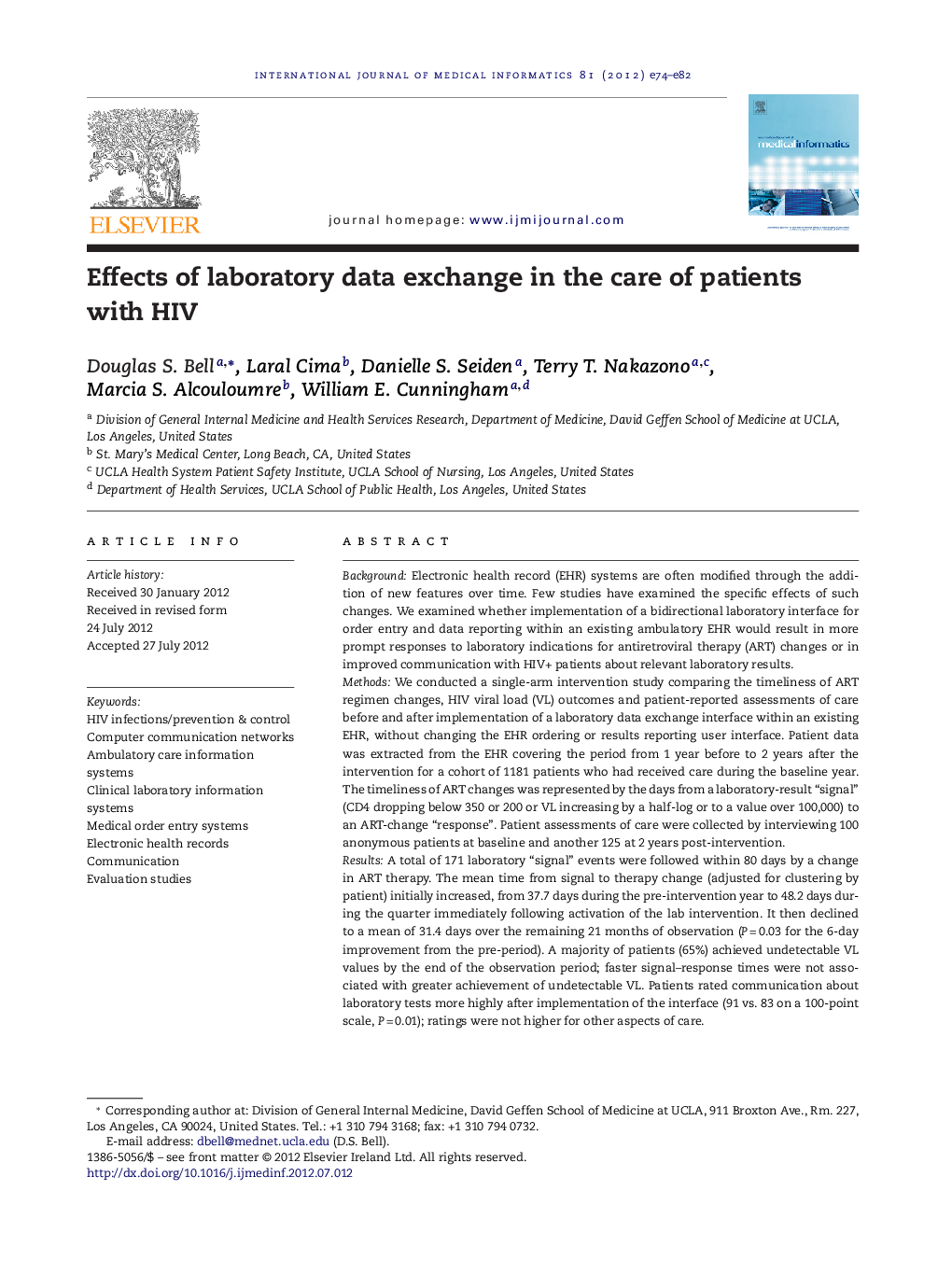| کد مقاله | کد نشریه | سال انتشار | مقاله انگلیسی | نسخه تمام متن |
|---|---|---|---|---|
| 516625 | 1449142 | 2012 | 9 صفحه PDF | دانلود رایگان |

BackgroundElectronic health record (EHR) systems are often modified through the addition of new features over time. Few studies have examined the specific effects of such changes. We examined whether implementation of a bidirectional laboratory interface for order entry and data reporting within an existing ambulatory EHR would result in more prompt responses to laboratory indications for antiretroviral therapy (ART) changes or in improved communication with HIV+ patients about relevant laboratory results.MethodsWe conducted a single-arm intervention study comparing the timeliness of ART regimen changes, HIV viral load (VL) outcomes and patient-reported assessments of care before and after implementation of a laboratory data exchange interface within an existing EHR, without changing the EHR ordering or results reporting user interface. Patient data was extracted from the EHR covering the period from 1 year before to 2 years after the intervention for a cohort of 1181 patients who had received care during the baseline year. The timeliness of ART changes was represented by the days from a laboratory-result “signal” (CD4 dropping below 350 or 200 or VL increasing by a half-log or to a value over 100,000) to an ART-change “response”. Patient assessments of care were collected by interviewing 100 anonymous patients at baseline and another 125 at 2 years post-intervention.ResultsA total of 171 laboratory “signal” events were followed within 80 days by a change in ART therapy. The mean time from signal to therapy change (adjusted for clustering by patient) initially increased, from 37.7 days during the pre-intervention year to 48.2 days during the quarter immediately following activation of the lab intervention. It then declined to a mean of 31.4 days over the remaining 21 months of observation (P = 0.03 for the 6-day improvement from the pre-period). A majority of patients (65%) achieved undetectable VL values by the end of the observation period; faster signal–response times were not associated with greater achievement of undetectable VL. Patients rated communication about laboratory tests more highly after implementation of the interface (91 vs. 83 on a 100-point scale, P = 0.01); ratings were not higher for other aspects of care.ConclusionsAdding laboratory data exchange interfaces within existing EHRs holds promise for improving HIV care, both in the timeliness of responses to important laboratory results and in the quality of provider communication about lab tests. However, the benefits from this incremental change may be modest unless more extensive redesign of laboratory follow-up workflows is undertaken, with support from enhanced user interfaces that take advantage of the laboratory information delivered. Providers should also consider increased staffing to compensate for dips in follow-up performance during the initial post-implementation months.
► Electronic interchange of test orders and results between EHRs and clinical laboratories is expected to improve care by ensuring that the correct tests are obtained and that results are matched and followed up in a timely manner for all ordered tests.
► Few studies have examined the effects of implementing electronic laboratory data exchange within electronic health records.
► Our study, the first we are aware of to examine electronic laboratory data exchange in HIV care, found that it improved the timeliness of adjusting antiretroviral medications and patients’ assessments of communication about laboratory tests.
► Further research is needed on redesigning workflows and user interfaces to take greater advantage of the data that is made available through electronic data exchange.
Journal: International Journal of Medical Informatics - Volume 81, Issue 10, October 2012, Pages e74–e82